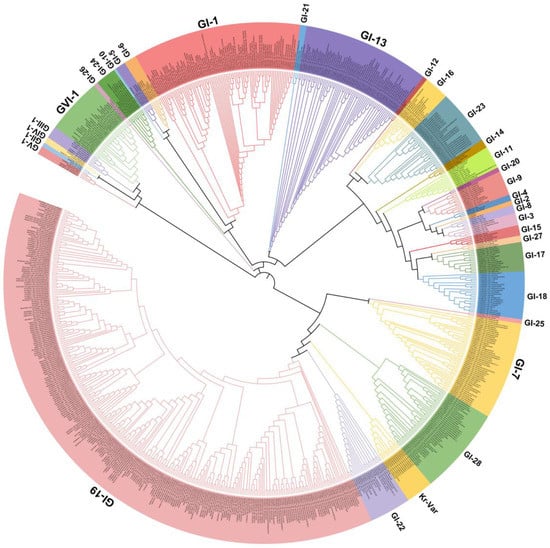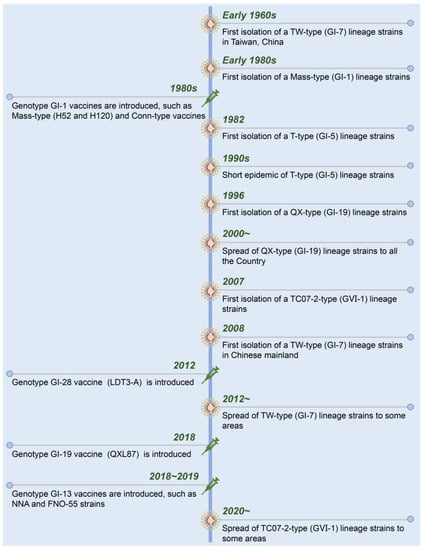You're using an outdated browser. Please upgrade to a modern browser for the best experience.
Please note this is a comparison between Version 1 by Zhang Guozhong and Version 2 by Beatrix Zheng.
Infectious bronchitis virus (IBV) is an enveloped and positive-sense single-stranded RNA virus. IBV was the first coronavirus to be discovered and predominantly causes respiratory disease in commercial poultry worldwide.
- coronavirus
- avian infectious bronchitis virus
- evolution
- genetic diversity
1. Genetic Diversity of Avian Infectious Bronchitis Virus
High rates of mutation, short generation times, and large population sizes drive the rapid evolution of RNA viruses, and consequently, most of the viral outbreaks over the last 100 years have been caused by RNA viruses [1][55]. Among the RNA viruses, positive-sense single-stranded RNA (+ssRNA) viruses such as IBV have the highest mutation rates [2][3][56,57]. IBV lacks a viral polymerase proofreading mechanism, and genetic mutation and recombination can continuously occur in the genome, especially in hypervariable regions of the S1 glycoprotein, which enables the continuous emergence of variants, genotypes, or serotypes [4][5][6][7][7,16,58,59].
IBV strains are clustered into six genotypes (GⅠ–GⅥ) using the complete nucleotide sequences of the S1 gene, and together these contain 34 distinct viral lineages and several inter-lineage recombinants [8][53]. Of these genetic lineages, GⅠ-1, GⅠ-3, GⅠ-5, GⅠ-6, GⅠ-7, GⅠ-9, GⅠ-11, GⅠ-12, GⅠ-13, GⅠ-15, GⅠ-16, GⅠ-17, GⅠ-18, GⅠ-19, GⅠ-21, GⅠ-23, GⅠ-24, GⅠ-25, GⅡ-1, GⅡ-2,GⅢ-3, GⅤ, GⅥ-1, and several variants exist in many countries. The GⅠ-1 (Mass-type), GI-13 (793B-type), and GI-19 (QX-type) lineages are widely distributed in many countries, and especially QX-like viruses are now globally widespread (Figure 1). GI-7 (Taiwan-I) lineage strains have also been mainly isolated in China in recent years. Notably, live-attenuated vaccines of the Mass-type (e.g., strain H120), 793B-type (e.g., strain 4/91), Delmarva-type (e.g., DMV/1639 in the USA), and QX-type (e.g., QXL87 in China) are commonly used in many farms or countries [9][10][11][12][13][14][8,48,60,61,62,63]. Therefore, the possibility that several IBV strains are responsible for the re-isolation of the vaccine viruses cannot be excluded.

Figure 1. Phylogenetic trees based on the complete S1 glycoprotein gene of the infectious bronchitis virus (IBV). The tree was generated using the neighbor-joining method in MEGA 7 software package with 1000 bootstrap replications. The IBV genotypes were defined as described by Valastro et al. [8][53].
A timeline with the date of isolation of each presenting IBV strain and used live-attenuated vaccines in China is shown in Figure 2. Suspected IB was first described in 1972 in Guangdong province, China [15][64]. Early in the 1980s, Mass-like IBV was isolated from Chinese chicken flocks that were genetically similar to that found in the USA. To control the diseases in chickens, the inactivated and live-attenuated vaccines of Mass (H52 and H120) and Conn serotypes were used. The IBV strains from T-type (GI-5), QX-type (GI-19), TC07-2-type (GⅥ-1), and TW-type (GI-7) were successively isolated from the vaccinated chicken flocks [16][17][18][65,66,67]. Currently, GI-19 (QX-type) and GⅥ-1 (TC07-2-type) lineage strains have become the dominant strains of IBV in China [19][20][21][68,69,70].

Figure 2. Chronological timeline showing the emergence and spread of the present IBV strains and introduction of live-attenuated vaccines in China.
2. Antigenic Diversity of Avian Infectious Bronchitis Virus
New IBV variants continuously emerge through genetic recombination and mutation, and several exhibit clear antigenicity differences revealed by cross-neutralization tests or monoclonal antibody analysis. The GI-19 lineage (QX-type) strains, for instance, are prevalent in many parts of the world, and are distinct from all other known IBV strains, indicating that these strains belong to different serotypes [22][23][24][71,72,73]. Antigenic variation of IBV is mainly associated with the spike protein because this is a major inducer of neutralizing antibodies and immunoprotection [4][5][20][25][7,16,52,69]. Other proteins, including structural or nonstructural proteins and accessory proteins, contribute to and influence antigenic differences [4][7][7,59]. Thus, antigenic variation of IBV is caused by various factors.
Currently, IBV exists as a serotype score worldwide, and most of these have poor cross-protection with each other [4][26][27][28][29][7,74,75,76,77]. This means that vaccination with a particular serotype of IBV may not provide protection against other serotypes. As a result of the antigenic variation, the disease presents a continuing coexistence of multiple serotyping strains, meaning that the production of new IB vaccines that better match the prevalent virus strains will likely continue for a long time. To address the major challenge of IBV antigenic diversity, researchers have focused on understanding the genetic mechanisms underlying IBV evolution, developing new vaccines with cross-protection, improving biosecurity measures to prevent viral spread, and so on.
3. Multiple System Disease Caused by Avian Infectious Bronchitis Virus
Most IBVs can infect the respiratory, renal, and reproductive systems of chickens. Following the initial infection in the respiratory tract with clinical signs (sneezing, gasping, coughing, tracheal rales, nasal discharge, and dyspnea), IBV is disseminated to other tissues by viremia [27][75]. One possible mechanism is that some strains could infect blood monocytes, and therefore facilitate the dissemination of IBV to visceral organs [30][31][78,79]. IBV dissemination beyond the respiratory tract may involve the lymphatic system and infected macrophages as with several other viruses [32][33][80,81]. Compared with other IBV strains, the nephropathogenic strains have received increased attention because of their higher virulence in young birds [34][42]. The kidneys of nephropathogenic IBV-infected chickens are pale, discolored, and enlarged with obvious urate deposition on post-mortem examination [31][35][36][79,82,83]. IBV infections in young chickens are common between the ages of 1 to 30 days and can cause reproductive tract defects [37][38][39][84,85,86]. The infected chickens develop cystic oviducts, leading to false layer syndrome with distinctly low peak egg production [39][40][41][42][86,87,88,89]. Infection with IBV in laying hens can negatively influence egg production with poor-quality eggs [43][44][45][90,91,92]. Several IBV strains can infect the nervous system of chickens [46][93]. These strains contain an extra furin cleavage site upstream of the fusion peptide (S2’ site) enabling them to infect monocytes and neuron cells, thus leading to viremia or encephalitis in chickens [30][46][78,93].
Although differences in clinical and pathological outcomes in chickens depend on the infecting IBV strain, many IBV strains can simultaneously infect multiple physiological systems in chickens, which is termed “multiple symptoms with one virus” (Figure 3). First, IBVs can infect the respiratory system of chickens, causing damage to the integrity of the respiratory mucosa, which could increase the susceptibility to secondary viral and bacterial infections [22][47][48][49][71,94,95,96]. Second, IBVs can infect the renal system, leading to increased mortality [22][35][48][50][51][71,82,95,97,98]. Third, IBVs can infect the reproductive system of chickens, reducing egg production with poor shell quality or with false layers [38][39][48][52][53][18,85,86,95,99]. Fourth, IBVs can infect the nervous system of chickens, causing significantly increased mortality [30][46][78,93]. Studies of IBV and host interactions could help to understand the tropism of IBV in various body systems and act as a model to contribute an invaluable resource for studying other pathogenic CoV diseases.

Figure 3. Schematic diagram showing clinical manifestations of IBV infection. Clinical signs and main outcomes are summarized, showing the effects of the virus on different body systems.
4. Prevention and Control of Avian Infectious Bronchitis Virus
In modern poultry farms, an effective management system and biosecurity measures are of primary importance to control infectious diseases. This premise is based entirely on the correct understanding of the factors influencing viral spread, as with the avian influenza virus [54][55][56][100,101,102]. Therefore, a more comprehensive analysis of the epidemiological aspects behind the spread of IBV, especially the spreading determinants, is critical and urgently required [57][58][103,104].
Despite drawbacks, including severe reactions to vaccination at the day of age, the likelihood of viral recombination, and frequent vaccine replacement caused by viral mutation, vaccination remains the most effective control measure for IB [59][60][61][62][63][105,106,107,108,109]. Efficient and properly performed vaccination may reduce the emergence of clinical signs, infectious pressure, and viral population size [59][105].
Currently, almost all commercial chicken flocks are vaccinated against IBV. The most effective IB vaccine is the live-attenuated vaccine, and H120 is one of the excellent vaccine strains widely used in the world. The vaccination protocol for IBV can vary depending on the vaccine used and the specific conditions of the poultry operation. In general, chicks are vaccinated at one day old or at hatchery, and then again several times throughout their life to maintain immunity. Booster vaccinations may be given at 7–10 days of age, at 3–4 weeks of age, and then every 5–6 weeks thereafter. Because of the many existing variants worldwide, the concept of protectotype has been increasingly accepted for controlling IB. One of the most commonly applied protectotype vaccination protocols against IB in the EU is the simultaneous or alternate use of Ma5 and 4/91 vaccine strains to provide protection against homologous or heterologous IBV strains [64][110]. In China, the H120 vaccine combined with an endemic strain, such as QXL87 (QX-like, GI-19), FNO-55 (4/91-like, GI-13), or LDT3-A (YN-like, GI-28), is commonly used to control IB.
Different vaccine platforms have been designed to develop effective vaccines against IBV. However, new vaccine techniques are rarely used because of the relatively complex immune protection mechanism and are currently only in the laboratory research stage [14][65][66][67][68][69][70][71][63,111,112,113,114,115,116,117]. Consequently, both inactivated and live-attenuated IBV vaccines are widely available worldwide [72][73][74][75][118,119,120,121].
